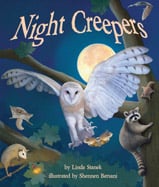Alignment to CORE and NGSS Standards

| Grade | Number | Standard |
|---|---|---|
| 1 | L.1.5b | Define words by category and by one or more key attributes (e.g., a duck is a bird that swims; a tiger is a large cat with stripes). |
| 1 | NGSS: 1-LS1.A: | All organisms have external parts. Different animals use their body parts in different ways to see, hear, grasp objects, protect themselves, move from place to place, and seek, find, and take in food, water and air. Plants also have different parts (roots, stems, leaves, flowers, fruits) that help them survive and grow. (1-LS1-1) |
| 1 | NGSS: 1-LS1.B | Adult plants and animals can have young. In many kinds of animals, parents and the offspring themselves engage in behaviors that help the offspring to survive. (1-LS1-2) |
| 1 | NGSS: 1-PS4.B-1 | Objects can be seen only when light is available to illuminate them. Some objects give off their own light. (1-PS4-2) |
| 1 | RI.1.9 | Identify basic similarities in and differences between two texts on the same topic. (story versus For Creative Minds non-fiction component) |
| 2 | NGSS: 2-LS4.D | There are many different kinds of living things in any area, and they exist in different places on land and in water. Classification (2-LS4-1) |
| 2 | RI.2.4 | Determine the meaning of words and phrases in a text relevant to a grade 2 topic or subject area: Earth processes: quickly/slowly, wind/water shape land, plate tectonics, maps, water: ocean/rivers/lakes-solid or liquid, STEM: drawings, plant basic needs, seed dispersal, biodiversity, state of matter: solid/liquid, small objects make larger, heating/cooling substance causes observable change, add/subtract 100-20 mentally, equal groups for multiplication foundation, odd/even numbers, place value 3 digits, skip counting, measure length using 2 different measurements (inches/feet/yard/cm/m), compare objects by measurement, number line, time to 5 minutes, money/currency, line plot, picture graph, bar graph 4 categories, shapes/angles/number faces, divide shapes into halves, thirds, quarters, fables/folktales from diverse cultures, rhyme and rhythm, compare two/more versions same story, collective nouns |
| 2 | RI.2.9 | Compare and contrast the most important points presented by two texts on the same topic. (story versus For Creative Minds non-fiction component) |
| 3 | L.3.6 | Acquire and use accurately grade-appropriate domain-specific words and phrases: Weather prediction, weather versus climate, natural hazards, life cycles, changing environments: organisms survive/move/adapt/die, animal group behavior, inherited traits, instinct/learned behavior, extinct animals, fossils, individual advantages survival/mating, habitat survival: physical/behavioral adaptations, living things change habitats, force/motion: strength/direction/electric/magnetic, multiplication/division, unknown number m/d equation, m/d fact families, two-step word problems, place value rounding, fractions, time to minute, liquid volumes, scaled picture graph/bar graph, measurements to fractional inches, line plot, area, square units, area=multiplication/division, perimeter, shapes in different categories (rhombus/rectangle=quadrilateral), divide shapes by equal area, fables/folktales/myths from diverse cultures, compare/contrast stories from same author/series, |
| 3 | RI.3.9 | Compare and contrast the most important points and key details presented in two texts on the same topic. (story versus For Creative Minds non-fiction component) |
| 4 | NGSS: 4-LS1.A | Plants and animals have both internal and external structures that serve various functions in growth, survival, behavior, and reproduction. (4-LS1-1) |
| 5 | RI.5.5 | Compare and contrast the overall structure (e.g., chronology, comparison, cause/effect, problem/solution) of events, ideas, concepts, or information in two or more texts. (Paired reading-story versus For Creative Minds non-fiction component) |
| K | NGSS: K-LS1.C | All animals need food in order to live and grow. They obtain their food from plants or from other animals. Plants need water and light to live and grow. (K-LS1-1) |
| K | RI.K.9 | With prompting and support, identify basic similarities in and differences between two texts on the same topic. (comparing story to For Creative Minds non-fiction component) |